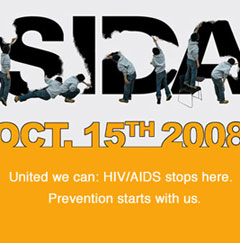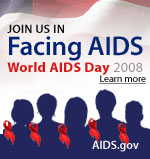Communities of Color and New Media Use: Part II
As we mentioned in our last post, after attending The United States Conference on AIDS  we wanted to get a clearer understanding of internet and new media use among communities of color. To learn more we hosted a webinar, “Underserved Populations and New Media Use,” for over 100 of our Federal colleagues and their grantees (visit our podcast page for the slides and an audio recording of the webinar). Last week, we discussed the presentation by Fard Johnmar, Founder of Envision Solutions, LLC.
we wanted to get a clearer understanding of internet and new media use among communities of color. To learn more we hosted a webinar, “Underserved Populations and New Media Use,” for over 100 of our Federal colleagues and their grantees (visit our podcast page for the slides and an audio recording of the webinar). Last week, we discussed the presentation by Fard Johnmar, Founder of Envision Solutions, LLC.  Our other webinar speaker was Alejandro Garcia-Barbon, Senior Technical Advisor to IQ Solutions, Inc.
Our other webinar speaker was Alejandro Garcia-Barbon, Senior Technical Advisor to IQ Solutions, Inc.  He presented about the “Drugs + HIV > Learn the Link” Campaign of the National Institute on Drug Abuse (NIDA).
He presented about the “Drugs + HIV > Learn the Link” Campaign of the National Institute on Drug Abuse (NIDA).
NIDA’s “Drugs + HIV > Learn the Link” Campaign: What is it all about?


The campaign designed their first public service announcement (PSA), “Text Message,” to reach young African American women with information about non-injection drug use and HIV. The PSA’s success led to the creation of a PSA to reach young Hispanic women. The result was “After the Party,” a PSA available in both Spanish and bilingual English-Spanish versions, about a young woman who receives an HIV-positive diagnosis.
The campaign’s website has resources for teens on HIV and drugs along with five webisodes that continue the story of the characters in the PSAs. They use other new media tools, like MySpace  , as a means to distribute and promote their messages.
, as a means to distribute and promote their messages.
Stephen Perez, a registered nurse who works with the Latino community in San Francisco around HIV/AIDS, told us, “I encourage my clients to reflect on the impact of alcohol and drugs in their lives. This site helps to reinforce these messages. The use of new media tools, like MySpace, to further promote the campaign reaches many young Latinos where they are already spending time.”
How can I use these tools to get ready for National Latino AIDS Awareness Day (NLAAD)?

October 15 is National Latino AIDS Awareness Day  . In anticipation of this important day, consider sharing the “Drugs + HIV > Learn the Link” resources with your colleagues and friends. And check out another campaign targeted to Hispanic audiences: the Soy (I am)
. In anticipation of this important day, consider sharing the “Drugs + HIV > Learn the Link” resources with your colleagues and friends. And check out another campaign targeted to Hispanic audiences: the Soy (I am)  project, a joint venture
project, a joint venture  between Univision
between Univision  and the Kaiser Family Foundation.
and the Kaiser Family Foundation.  Soy tells the stories of individual Latinos living with HIV/AIDS; another example of using new media to start conversations, reduce stigma, and link people to important information and resources.
Soy tells the stories of individual Latinos living with HIV/AIDS; another example of using new media to start conversations, reduce stigma, and link people to important information and resources.
What are lessons learned for programs wanting to use new media tools to reach underserved communities with HIV/AIDS messages?
- Tell a story. By making the characters and their actions realistic and relevant to the lives of their target audience (young African American and Hispanic women), the NIDA campaign draws the viewers in and makes them care about the content.
- Have good content. A good story isn’t enough by itself - the information has to be accurate and link the viewer to the additional resources they need.
- Be flexible. By using a variety of formats - webisodes, radio and TV PSAs, print and online materials - including some that are effectively accessible without a broadband internet connection - and marketing them in different ways, the campaign responds to the reality of where their audience gets information and how they want to receive it.
With just one week to go, it’s also time to register  your NLAAD event or find one to attend. And stay tuned next week for more on using new media to reach the Latino community and the Latino Commission on AIDS!
your NLAAD event or find one to attend. And stay tuned next week for more on using new media to reach the Latino community and the Latino Commission on AIDS! 




Thanks for covering this very important topic but I must say I am very concerned by the NIDA video associated with this blog. While it is obvious the video message is focused on the connection between substance abuse and HIV, it is also clear that the video is promoting the "outing" of someone's HIV status to a third party. What is not clear is why NIDA did not see this (or worse, if they did), and it is not clear whether the woman had permission to disclose her friend's HIV status. This video is basically saying it is okay to violate someone's confidentiality (is that even legal?). Yes, we want to eliminate stigma, but outing people is not going to help, even if it is among friends? Will this video encourage folks to be tested, or will it encourage them not to tell others since they do not know how that person will share the information. True, disclosing one's HIV status can help reduce stigma, but it must be a personal choice. Folks must be able to decide when it is the right time to disclose their own HIV status, and the government should be doing all it can to promote a safe environment for them to do so. This video does just the opposite. True, not every issue can be covered in a short video, but if we are going to use new media then we have an extra obligation to make sure the meesages we are trying to convey do not promote ideas which will make it less likey for people to self-disclose their HIV status. Do others see it the same way?
Thanks.
Posted by: Matthew | October 09, 2008 at 09:29 AM
Thank you for your interest in this topic. We learned in our research that teens respond to stories that reflect real life. In this story, the affected girl had obviously shared this information with friends. We believe this reflects the reality of some young people who get HIV/AIDS.
If it were a doctor revealing this confidential piece of information, we would understand the concern about privacy; but we are telling one story about one young woman to illustrate an extremely important point - that is, drug and alcohol use can lead to impaired judgment and risky sexual behaviors that can result in HIV infection. To see the continued storyline, go to http://hiv.drugabuse.gov/english/message/webisodes.html. There is a second video spot as well as webisodes that carry the story forward.
We appreciate your feedback.
Public Information & Liaison Branch
National Institute on Drug Abuse, NIH
Posted by: Public Information & Liaison Branch | October 15, 2008 at 12:57 PM
Thank you, NIDA and Matthew, for your thoughtful dialogue. We appreciate your willingness to engage in this conversation.
Posted by: The AIDS.gov Team | October 15, 2008 at 05:31 PM